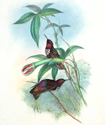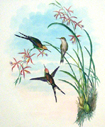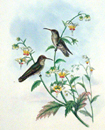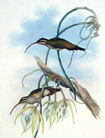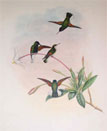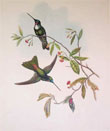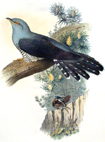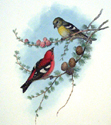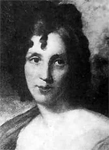
 |
(Click images to enlarge and for purchase information.) Want to know more about prints? |
|||||
|
John Gould was the son of a gardener appointed to the Royal Gardens at Windsor during the reign of George III. Gould grew up in gardens and meadows and at the age of 14 was apprenticed to learn the same trade as his father. He recalled in his old age one of his tasks was to pick “many a bunch of dandelion leaves” for the elderly Queen Charlotte’s favorite dandelion tea. During this time, Gould also became skilled in the art of taxidermy. By the age of 21, Gould had given up his position as a gardener for the business of taxidermy. In 1827, he was appointed “Curator and Preserver” to the Museum of the newly created Zoological Society of London, presided over by Sir Stamford Raffles. This position led to work for George IV, who requested Gould stuff his prized giraffe. The giraffe, a gift from an Emir of Egypt, was the first live giraffe seen in England and had traveled across the desert strapped to the back of a camel. Unfortunately, the poor animal never fully recovered from its desert trek and died within two years of its arrival in England. At the age of 24, Gould married Elizabeth Coxen, whose genteel manners gave the rustic Gould some social poise, but more importantly her drawing skills helped produce his first work A Century of Birds from the Himalaya Mountains 1831-32. Gould had the ability to make swift sketches, but never developed those skills, instead relying first on his wife and then a number of excellent professional artists. These included W.M. Hart, Edward Lear, H.C. Richter and Joseph Wolf. Edward Lear, known by school children for his nonsense poems and limericks, was also a brilliant artist. His work, The Family of Parrots 1830-32, which is still widely acclaimed, was an early lithographic production. This skill of drawing on stone, he passed on to Elizabeth Gould. During the twelve years of their marriage, Elizabeth drew and lithographed some 600 illustrations for John Gould’s books, had eight children (two died early) and accompanied him on one of the most daring expeditions that could have then been devised: a trip to Australia and Tasmania lasting two years(1838-40). She died of puerperal fever shortly after the birth of their last child in 1841. Gould was highly industrious and organized a kind of factory for producing Natural History books. His forty folios, containing 3,999 plates, covered birds of Europe, Asia, Australia, New Guinea and Great Britain, as well as individual families of birds, including Hummingbirds, Partridges, Toucans and Trogons. To fully comprehend the magnitude of producing and hand-coloring each plate in each copy of each work, Gould writes, “Many of the public are quite unaware how the coloring of these large plates is accomplished…every sky with its varied tints and every feather of each bird were colored by hand; and, when it is considered that nearly two hundred and eighty thousand illustrations in the present work (Birds of Great Britain 1862-73) have been so treated, it will most likely cause some astonishment to those who give the subject a thought.” This represents over 700 copies of the Birds of Great Britain with each copy of five volumes containing 367 plates. A prodigious body of work representing only one of his 17 different publications!
|
||||||

